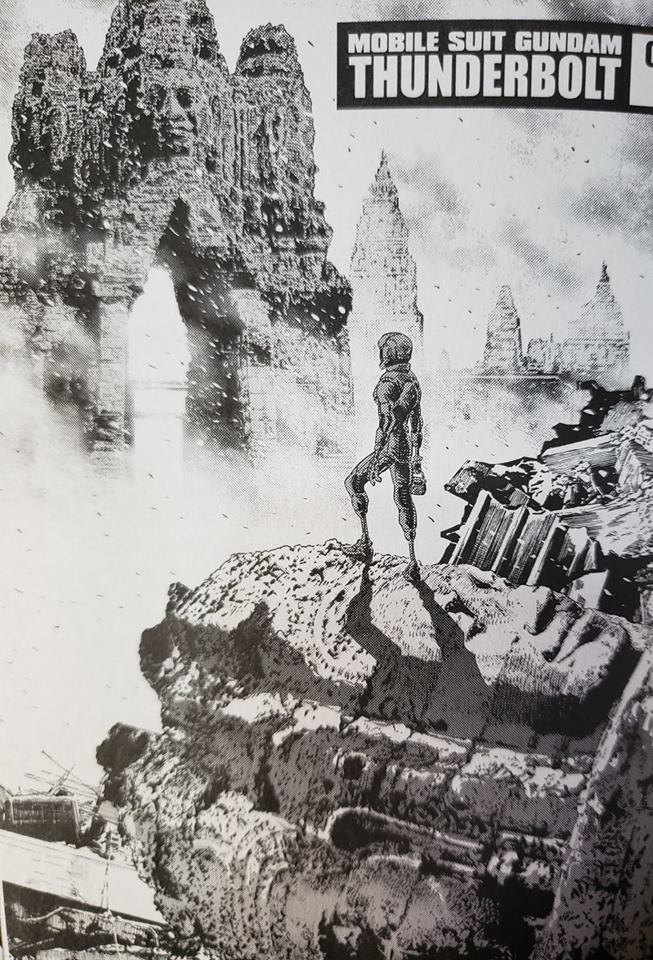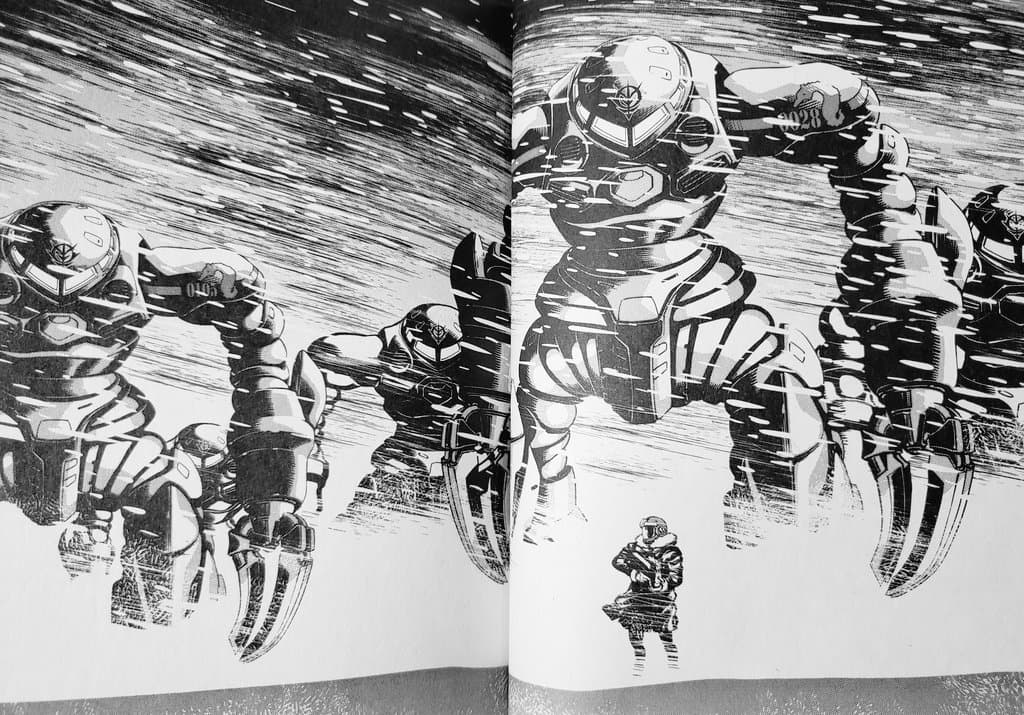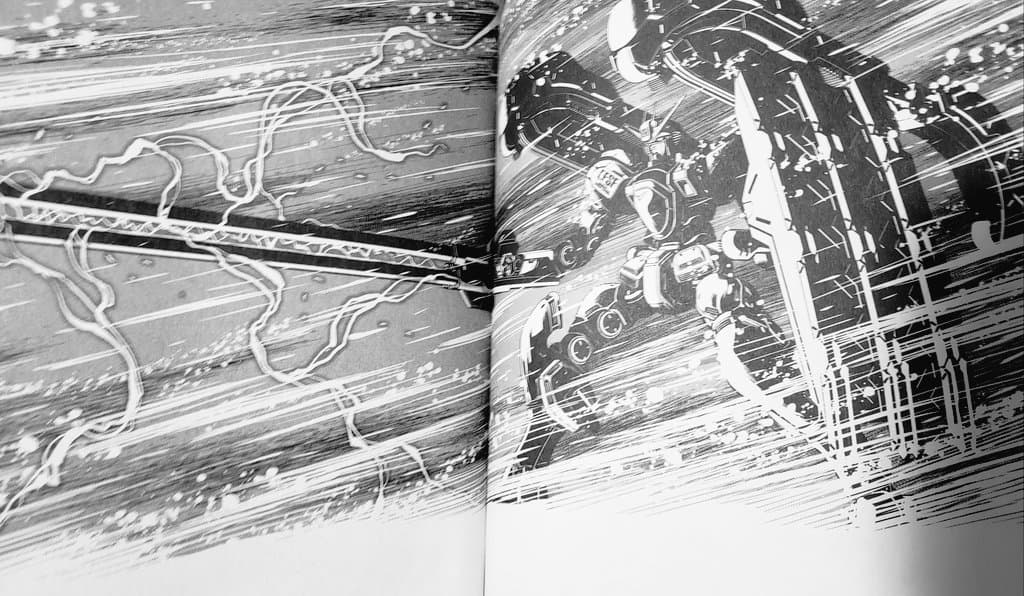There were a lot of good comics this year, but the one that I was most excited to read every few months when a new volume came out was Yasuo Ohtagaki’s Mobile Suit Gundam: Thunderbolt. I was actually on a panel for best comics of the year at Thought Bubble in Leeds, and everyone around picked all of these respectable books from Short Box and Koyama, and I felt weird having to say it, but it’s true. Mobile Suit Gundam: Thunderbolt is really one of the best comics of the year.
But the thing I’ve really struggled with is how exactly to explain that. That’s why I haven’t written about the book until now. To briefly summarize, Thunderbolt is a comic that takes place in the UC century universe of the Gundam giant robot series. It takes place during the One Year War, and then right after it, and largely focuses on the rivalry of two men(as most Gundam series do), in this case Daryl Lorenz, a quadruple amputee newtype Zeon pilot and the Jazz loving Earth Federation jerk Io Fleming. The two initially cross paths in the Thunderbolt sector, which is the ruins of a space colony zeon destroyed, and because of the strange electromagnetism in the area, there are the space thunderbolts--thus “Thunderbolt sector”--Lorenz is the top sniper of a unit of amputee Zeon soldiers who are part of an experiment to build the psycho system. And Io is the ace of the Moore Brotherhood unit representing the Earth Federation. The two fight it out there, and then again in the battle at A Baoa Qu, which was Zeon’s last stand in the One Year War. Zeon lost, and the next we see is Lorenz and Io on earth. With Zeon remnants still fighting against the Earth Federation, and the Feddies after the Nanyang alliance, which is a religious cult that is trying to rebuild the Psycho Zaku. And that’s pretty much where we are at now without spoiling anything.
But this is far from the first Gundam manga. There’s generally a manga for every anime series, and then a few besides that. This one is somewhat notable in that the anime series is an adaption of IT and not the other way around. But Yoshikazu Yasuhiko showed with his brilliant masterpiece Origin series that even gundam adaptations can be good. But I bring it up just to say it’s not notable for being a comic that is about gundam. That’s not what makes it great.
Yaz’s Origin series is interesting to bring up, because I think that is a comic that is executed on the highest level of the medium, a true master, hitting every mark. And while I wouldn’t describe Thunderbolt as that, I would say that there’s more of Thunderbolt that leaves me awestruck. Every panel isn’t great. A lot of them aren’t really. But there’s just enough to keep you hungry, and the payoff 9 volumes in, comes through everytime.
So I don’t think it’s original. I don’t think it’s per se super intellectually challenging. I don’t think every panel is a masterpiece to look at. And yet...it’s so fucking good.
This is a segment of pages from one of the best volumes of the series so far, Vol. 6, which came out in February from Viz. Vol. 6 is the perfect volume to bring to the table here, because it encapsulates everything that I’ve said. It uses a time shift framing device for heightened suspense and to build how much you care about certain characters before their fates are decided--which is kind of cringe. But the other side of the book which is a series of reversals of fortune between Federation and Zeon remnants is absolutely brilliant. It starts with Zeon remnants destroying a Federation ball on patrol, which lures the Federation forces out into a trap underwater against a bunch of Z’Gok’s and Goggs, which are made for fighting underwater. Bianca Carlyle is able to flip the tables and forces a the Zeon commander to the surface and out of his suit. And just as she’s about to shoot him in the head. A force of Zeon Gogg’s appear behind her. And then just as she’s about to be smashed, Io appears with the Atlas Gundam, takes out the Zeon forces, saving Carlyle, before then having to be saved by her in his encounter with a mobile armor. That kind of shifty reversal of power is something that is all through Thunderbolt, and something Ohtagaki has down really well, and it always makes you power through these books.
But beyond that, his depiction of mobile suits is I think extremely notable. It’s actually not that easy to make giant robot fights look consistently cool in comics. There are kind of precious few truly great mecha comics out there. And I would say this is something even Yaz struggled with in Origin. Ohtagaki though, as you can see in the above images, cycles through how heavy his blacks are, and the type of rendering he does, for dramatic effect really well. And his scale for the mobile suits is always very dramatic. You get the sense of how large they are, but also how fast they can move. Which is really hard in the comic medium. And when he hits you with the texture shifts in dramatic moments, it really pops the action out on the page.
Compare the heavy blacks on the mobile suits in the above page, with the more detailed and precise lines of the Atlas Gundam here:
That gives you a sense of the kind of range he can shift in between, and I think it’s this versatility in depiction that is a very strong card in Ohtagaki’s deck. It extends to his characters as well, who he also sometimes shifts between heavier and lighter lines. It’s total spectacle.
I put a lot of stock in comics that I can turn the page and be like “whoa”--and that’s not just about being an excellent draftsman. I think there are a lot of artists who can draw better than Ohtagaki, but very few have that honed sense of how to make the amazing look amazing.
I also think Ohtagaki has a weird vibe to his work. And this extends to Moonlight Mile. There’s something prurient at times, debauched--it’s not overt, but like the Moore Brotherhood captain’s drug addiction, and things like that, coupled with the almost manic eyes that Ohtagaki draws creates this atmosphere in Thunderbolt that is….hard to put your finger on. But it’s there. It’s there in the anime too, but I think it’s even stronger in the comic. It’s not pervy. But it’s nihilistic? The characters are all empty or feel empty when you look at them, in a very specific way that makes you feel like everyone in thunderbolt is just insane, and that they are fighting not so much to win a battle or a war, but to hear themselves scream. To actualize the pain they are carrying into a moment that it can possibly be exercised.
The metaphor Ohtagaki uses is music. The conceit of Thunderbolt is that the mobile suit ace isn’t fighting a war, they are participating in their art form, this form of expression at its deadliest. To some extent that’s always the case with the ace pilot. Our conception of the Ace is that he is someone who is beyond human in a way that allows him to fight war beautifully, or in a way that causes us to notice him or her as the ace. The cycle of a traditional gundam myth is a young pilot is forced into war, and they become the ace, in order to express their terror, their fear, and their rejection of war, of killing, and to try and instead connect with a wider evolution of human consciousness that could end all war(the newtype myth)--if we could only understand each other, then we wouldn’t kill each other, is the hope. And it’s interesting because both Daryl and Io listen to music while they fight. Different genres, but for both music is a huge part of their lives. Which is kind of a double metaphor, as Io sees flying the gundam as music--so they are joined both by music, and their role as aces, who want to express themselves but so far haven’t. So there’s stuff to unpack for sure with Thunderbolt.
So there are things to think about in Thunderbolt. I think it’s also the first gundam myth to try and tackle a religious cult. Gundam 00 tried, but I wouldn’t say to this extent. As Celestial Being weren’t so much a religious cult, as a conspiracy of alien types. Which is a tough thing to decide your going to wrestle with in Gundam, but I am interested to see where Ohtagaki goes with it.
I would say for a comic as enjoyable to read and action packed as Thunderbolt is, there aren’t many comics that also carry the weight and heavy atmosphere as well as Thunderbolt does. It’s a unique experience every month it comes out, and a beautiful study for anyone who is interested in how to make dynamic giant robot fights in comics. Which is also probably a huge part of why it’s such a big book for me personally, because it really is like getting taken to school on how to do this genre, particularly how to to the action, and I say that as someone who has read Origin and Five Star Stories and some of the other gundam manga--they don’t have a patch on the best battles in Thunderbolt. It is truly stunning work.





